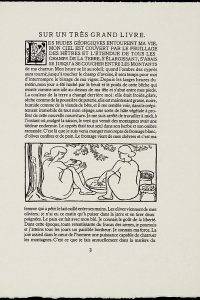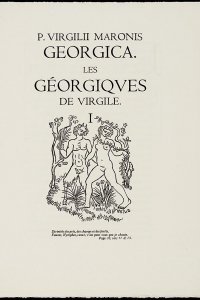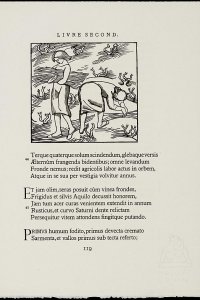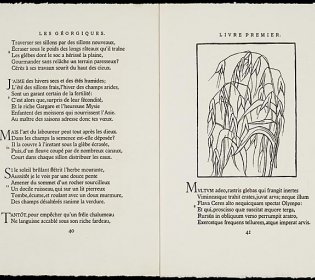Les géorgiques
Year: 1950
Author: Virgil (70 - 19 BC)
Artist: Aristide Maillol (1861 - 1944)
Publisher: Philippe Gonin, éditeur
By 1914 Kessler had already formulated a plan for an edition of the 'Georgics', but it never developed beyond the proofs for a German-Latin edition. At that time no woodengravings were available, and although Maillol produced at least one wood engraving during that period ('Les épis de blé', ca. 1915), he did not start work on a series of engravings for Les géorgiques until the Gonin brothers encouraged him seriously in 1939. The wood engravings illustrate the didactic poem on agriculture, which was never intended to be used as an agricultural manual. It was an ode to life in the country, divided into four books on agriculture, forestry and winery, livestock-farming and beekeeping. The myth of Orpheus and Eurydice was referenced in the last part. The epic, written in hexameter, alternated descriptions of agricultural practices with lyrical passages. It was translated into French in 1769 by Abbot Jacques Delille (1738-1813). His translation was written not only for art lovers or classicists: his intention was to present the 'Georgics' to a wide audience. Voltaire considered this to be impossible, but the translation became enormously successful, thanks in part to a renewed interest in agriculture (between 1750 and 1820) and the establishment of scientific academies.
The 121 wood engravings were printed on a hand-press by Philippe Gonin. The two-volume edition consisted of 750 copies – numbered on the press – on rag paper bearing a watermark (a nude seated above the names Maillol and Gonin) that strongly resembles the Cranach Presse watermark of the first Virgil edition. The French text has been printed on the left pages, opposite the Latin text on the right. Line numbers and initials for each verse appear in the margins, in black, like the rest of the text. This is a strikingly homogenous black-and-white artist's book: no distracting colours have been used, and the density of the wood engravings has been adapted throughout to the text block. The lines are those of a sculptor bringing to life the rounded shapes of human figures through contrasts in width, and who allows his instrument (the gouge) to be recognized in the angular and occasionally interrupted lines of his wood engravings. Many of the wood engravings are close to 10 cm square. The images are made up of sketched line drawings (for instance the outlines of sheep), more elaborately detailed landscapes (like the dancing peasants or erotic nudes and Poussin-like shepherd scenes), or detailed studies of crops, sometimes accompanied by their names (such as 'laurel'). Maillol noticed that Virgil had omitted the fig tree in his didactic poem, and added an illustration of it to his series of wood engravings.
Maillol did not live to see the publication of this edition: the book only appeared in print six years after his death. The handsome layout of the Gonin edition, with its sober rather than decorated initials,its well-considered balance between the Latin and French texts, and its two volumes with half-parchmentcovers, can certainly vie with the books from Cranach Presse. If the Cranach 'Eclogae' has been chosen as one of the 100 finest books of the twentieth century, then Les géorgiques must surely be number 101.
Bibliographical description
Description: Les Géorgiques / Virgile ; texte latin et version française de Jacques Delille ; gravures sur bois de Aristide Maillol. - Paris : Philippe Gonin, éditeur, 1937 [i.e.1950]. - [174] p. : ill. ; 34 cm
Printer: Dumoulin (Paris) (text) Philippe Gonin (wood engravings)
Edition: 750 copies
This copy: Number 27 of 750 on pure rag paper, with watermark Maillol Gonin
Typeface: Copy of a fifteenth century typeface
Bibliography: Bénézit 9-32 ; Monod 11339 ; Strachan 337
Shelfmark: KW Koopm K 312-313
References
- Aristide Maillol als Illustrator. Neu-Isenburg, Tiessen, 1977
- John Dieter Brinks, Das Buch als Kunstwerk. Die Cranach Presse des Grafen Harry Kessler. Laubach, Triton, 2003
- Paul van Capelleveen, Sophie Ham, Jordy Joubij, Voices and visions. The Koopman Collection and the Art of the French Book. The Hague, Koninklijke Bibliotheek, National Library of the Netherlands; Zwolle, Waanders, 2009
- Paul van Capelleveen, Sophie Ham, Jordy Joubij, Voix et visions. La Collection Koopman et l'Art du Livre français. La Haye, Koninklijke Bibliotheek, Bibliothèque nationale des Pays-Bas; Zwolle, Waanders, 2009
- Édouard Guitton, Jacques Delille (1738-1813) et le poème de la nature en France de 1750 à 1820. Paris, Klincksieck, 1974
- Marcel Guérin, Catalogue raisonné de l'œuvre gravé et lithographié de Aristide Maillol. Tome deuxième: Les lithographies, les eaux-fortes. Genève, Cailler, 1967
- Martin Hutner, Jerry Kelly, A century for the century. Fine printed books from 1900 to 1999. New York, The Grolier Club, 1999
- Bertrand Lorquin, Aristide Maillol. Paris, Seuil, 2002
- Renate Müller-Krumbach, Harry Graf Kessler und die Cranach-Presse in Weimar. Hamburg, Maximilian-Gesellschaft, 1969
- John Rewald, The woodcuts of Aristide Maillol: A complete catalogue with 176 illustrations. New York, Pantheon, 1951





